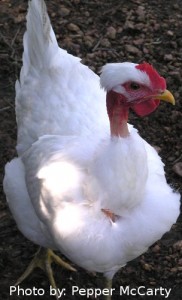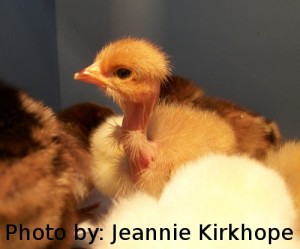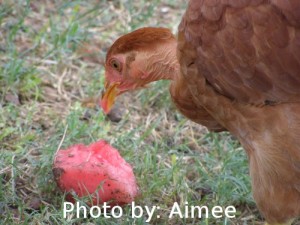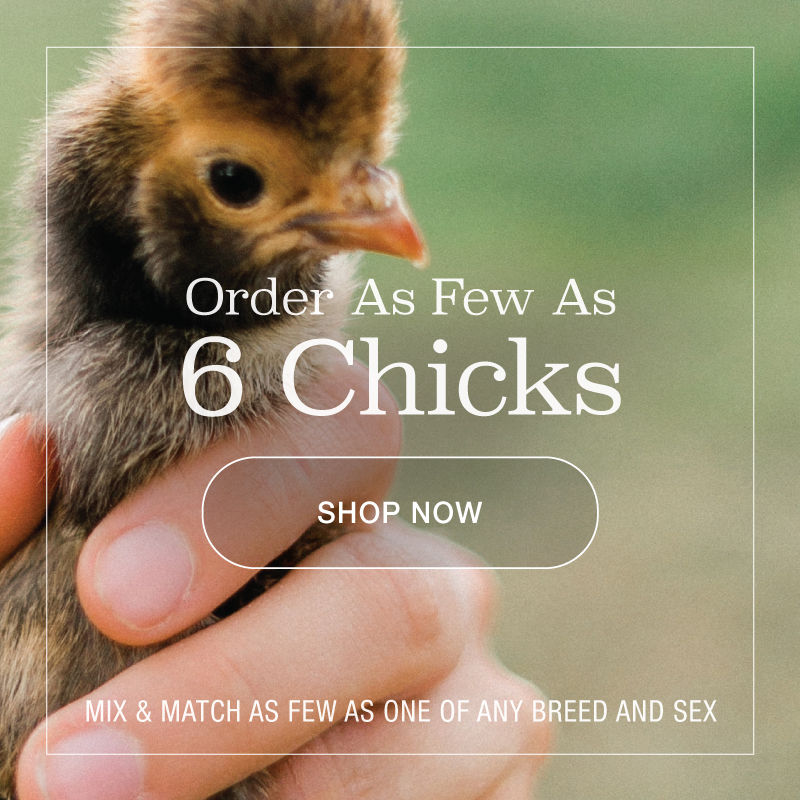History
The exact origins of Naked Necks, or Turkens, is uncertain, but some archaeologists believe they originated in Malaysia and spread from there. The popular name, Turken, comes from the mistaken belief that it was a cross between a turkey and a chicken, but the Naked Neck is all chicken. The current Naked Neck breed was developed in Eastern Europe in Hungary and Romania and later perfected in Germany in the nineteenth century. Naked Necks were admitted to the APA in 1965.
Qualities of the Turken
- Heat Tolerant – Because they have fewer and less dense feathers they are well-suited to hot weather. Naked Necks are also surprisingly cold hardy.
- Broodiness – Naked Neck hens may go broody. Those that do make excellent mothers.
- Temperament – Naked Necks are generally docile and friendly. Occasional Naked Neck roosters can be aggressive.
- Foraging – Naked Necks forage well and are well-suited to free range operations.
Naked Neck hens are good layers of medium to large, light brown eggs. They are well suited for backyard meat production.
Physical Appearance
The most obvious characteristic of this breed is the featherless neck and vent. Naked Necks have significantly fewer (about 40 to 50 percent as many) feathers as other breeds of comparable size.

- Coloration – Beak, shanks, and toes are yellow, eyes are reddish bay. The skin color is yellow.
- Comb – Medium-size single comb with five bright red well-defined upright points.
- Wattles – Medium size and bright red.
- Earlobes – Medium size, oblong, and bright red.
Availability on Our Website
To check the availability of Naked Necks on the Murray McMurray website, visit the link below:
Your Experience with Naked Necks
Have you raised Naked Necks? What do you think about them? Do you allow them to free range or keep them confined? Have your Naked Necks exhibited a tendency to go broody? What type of climate do you raise them in?
Name of Breed Naked Necks or Turkens date 2/24/2011
History
Some archaeologists believe the Naked Necks [Turkens] may have originated in Malaysia and spread from there over the globe in early times. The current Naked Neck breed was developed in the eastern European area of Hungary and Romania and later perfected in Germany in the nineteenth century. The Naked Neck gene is dominant and causes the first generation chick to also have naked neck. They were admitted to the Standard of Perfection in ???
Qualities of the Breed
Broodiness – Necked Hen will go broody and make excellent mothers.
Temperament – Naked Necks are generally docile, friendly and are suitable for t he family backyard and make excellent pets.
Climate – Due to the lack of numbers and density in the feathers they are well adapted to hot weather but are also tolerate of cooler temperatures.
Adaptability – Your Naked Neck will do well in a free ranging operation foraging for a high percentage of their sustenance and also tolerate confinement if not packed in too tightly.
Hens lay a fair number of medium to large light brown eggs with good food conservation. . They are especially suitable for meat production and dress easily as a broiler.
Physical Appearance
The outstanding characteristic of this breed is that it has a featherless neck and vent with a significantly reduced number of feathers over the remainder of the body. This trait is the result of a genetic makeup that reduces the size and density of feathers. The Naked Neck has only about 40 to 50 percent of the number of feathers that other chickens of comparable size normally have.
Coloration – Beak, shanks, and toes are yellow, eyes are reddish bay. The skin color is yellow
Comb – Medium-size single comb with five bright red well-defined upright points.
Wattles – Are medium size and bright red
Earlobes – Are medium size oblong and bright red.





I have a lovely Turken hen who is a favorite so I just ordered more. Teresa is a great little hen and very busy from day one. She is bonded to me and jumps in my lap from time to time. I’m always amazed at how much her crop stretches when she feeds. Her little feather tufts mid-way down her neck are adorable. I live at 5100 feet in Arizona with 95 degree summers and 6 degree winters and Teresa has never had a problem. I worried about sunburn, but she hasn’t had any problems unlike a few of my other hens with plucked heads who have had some problems, and I spray on a waterproof kid sunblock.
They do just fine here in Maine. In fact, during the winter (when it was below zero at times) my Naked Necks and my White Leghorns were always the first out of the coop in the morning! They fared the winter much better than my large birds like Brahmas. My Turkens are very sweet (even the rooster) and are good layers. I just have difficulty selling chicks as the breed is not very popular.
I thought that I must give some comments about Naked Neck chickens. When I was at Trincomalee district, I reared more than 20 Naked Neck birds, following a free range system. Trincomalee district belongs to the dry zone area in Srilanka, and it has a fairly hot climate. However, they can tolerate this condition and produced good quality eggs, and their meat quality is also the best and very taste compared with other exotic broiler breeds. They are robust birds and suitable for all weather conditions.
First experience with TNN’s (Transylvanian Naked Necks..love that name..conjures up vampire children with friendly featherless snacks..) is Wow! I love the temperament of our two pullets. They are obviously always thinking and seem about 10x brighter than the Barreds and the Orps. One had a little peck on its nape and I just carried it around for an hour or so after a little Neosporin. It seemed to love the experiences it had. Grotesque? Yes! but way cool chickens. More, I want more!
I have a Bantam Turkey Neck. She is very friendly and easy to handle and a good mother.
I have one Naked neck hen. Her name is Elvira, I bought her on Halloween 2009. She was the sweetest friendliest baby. She is still the nicest hen I have, lays very well, and has not yet gone broody. I highly recommend them. We are in hot southern California, and she does very well.
I live in Virginia and I have 6 Turkens. I have 4 hens and 2 roosters. They are very good layers of light brown eggs. The 2 roosters follow me around like dogs, and they are very gentle. The cold weather does not seem to bother them at all. I free range them when I am home, and they remain in the pen when I am working. Their strange appearance is a big conversation piece, but they are extremely social. Anyone looking to expand their flock or start one, I would strongly recommend Turkens.
I simply love my Turkens.
I got a Naked Neck hen a few years ago and really think she is one of the best I’ve ever owned – and I have a wide variety of chicken breeds. She lays huge eggs, does well free ranging, and is extremely gentle. She only purrs when I go to check under her for eggs, unlike many of my other hens who will give you a nasty peck. Last summer I found a collection of eggs outside the pen that she had started. I put them under a broody hen and hatched out three more turken hens. We live in central Wisconsin, and the winters here can be very cold (below zero) and lots of snow, and they have done very well over the winters. Currently mama turken is broody, so I’m thinking of giving her some duck eggs to see if she will hatch them. They are very different looking, but their other qualities out number their ‘looks.’
I purchased two about 3-4 years ago. I hatch some in my incubator in the spring and always include a turken egg. They are the neatest birds. My two originals were Thelma and Louise. Never has gone broody yet. I keep thinking of getting more. A really good breed.
Glad to see people are having good luck with the naked neck chickens. Our local feed supply store had a few left over out of an assortment of chicks. I had read about them, but already had plenty of chickens. Customers avoided those chicks like they were sick. I imagine someone finally bought them. I know I personally talked to one customer and told her that was way they were supposed to look. I may try them next year.
They are excellent layers. Always a hit when the ladies bridge club looks out the window and admires them in the yard.
We always had a few “turkey necks”, as we call them down here in East Texas, growing up. I was always excited to see some random yard hen with 10 or 12 babies and only one little turkey neck in the group. They’ve been my favorite for as long as I can remember. They’re so ugly they’re cute! On our recent order from McMurray I snuck in a few on my husband. I’m determined to convince him that they’re the best chicken ever!!
We loved our gentle Turken, which came in an “Assortment” pack. My little boy named her “Turkey” the first day she arrived looking so different from all the other chicks and Turkey she remained.
She was a good layer of eggs over several years, didn’t show aggression to other chickens, and did very well in the winter, laying eggs even when it was very cold. She was curious and friendly when we were around, and when we let our chickens out to forage, she did very well. She always came home to roost.
But the dangers of letting our hens forage is that they are open to predators and she was taken last year. We have since pumped up the netting and fencing so the girls are better protected and haven’t lost any since. We see a big difference in the taste and color of the eggs when the hens forage – much better taste, orange yolks, strong shells.
Ah! those turkens always get attention and catch your eyes. We always had a few Turkens with the other fowls in India where the temperature goes 104 degrees F for a few months. No other special attention I recall is needed. We always preferred turkens for quick meat, not because of the taste but because it is easy to dress them. Very funny, when a broody mom emerges with 8 or 10 of the baby Turkens. Have fun.
Sydney
At higher altitudes (as in Colorado), sun exposure will be more intense than in lower elevation locations (as in Virginia), so it is quite possible that the Naked Necks would benefit from sun protection. Humans that forget about that altitude effect on increasing sun exposure can get into trouble with severe sunburns during day hikes in high mountains.
Isn’t it just amazing the things we do for our animals? lol
I just purchased 2 Naked Necks and love them. They’re great with other chicks and will mix well in our Florida home.
My dad and I have raised Naked Necks all my life, and I am 62. In my part of KY we called them Rubber Necks. Have never used sun block. They do well as free range and do go broody and are hard to break from it. Continue to use them because they are both good eggers and meat chickens.
Love my Naked Necks. My big rooster is dominant on the farm over all the others. The NN gene is dominant, and all his chicks are Naked Neck. I have both the standard and bantam varieties, and they do great in hot Virginia summers. Wonderful birds. Nice, gentle, and great layers. We use our big rooster to introduce kids to chickens.
Yes ours have gone broody. They are prolific layers of giant eggs. They are friendly and easy to train. They do exceptionally well in our hot Colorado summers and our frigid Colorado winters. I just love them, and have over 20. They are great foragers.
They get along well with the other hens. They do get sunburned. We have put a sun block on there necks and wattles, and it does help. Turkens are the best chickens in my book.
Mine have done exceptionally well in APA shows, too.
You really put sunblock on their necks? I’m not sure they are suited for the Florida climate then. But if they stay in the shade maybe they would be OK. LOL!
Completely unnecessary. We don’t use sunblock and ours free-range everywhere.
Thanks for this! I had read Naked Necks would do well in Colorado, but we just got our first batch and after seeing them it’s hard to believe they really will be okay come December. Thanks for the reassurance!
We’ve had a few Turkens here in central Florida and never had to put sunblock on them. They’re great birds. We’ve had a few go broody, and one of our best brooders is a Naked Neck cross hen. This year she hatched out a couple of ducklings as well as her chicks and has been a great mama to both chicks and ducklings.
We’d love to get more of these birds.